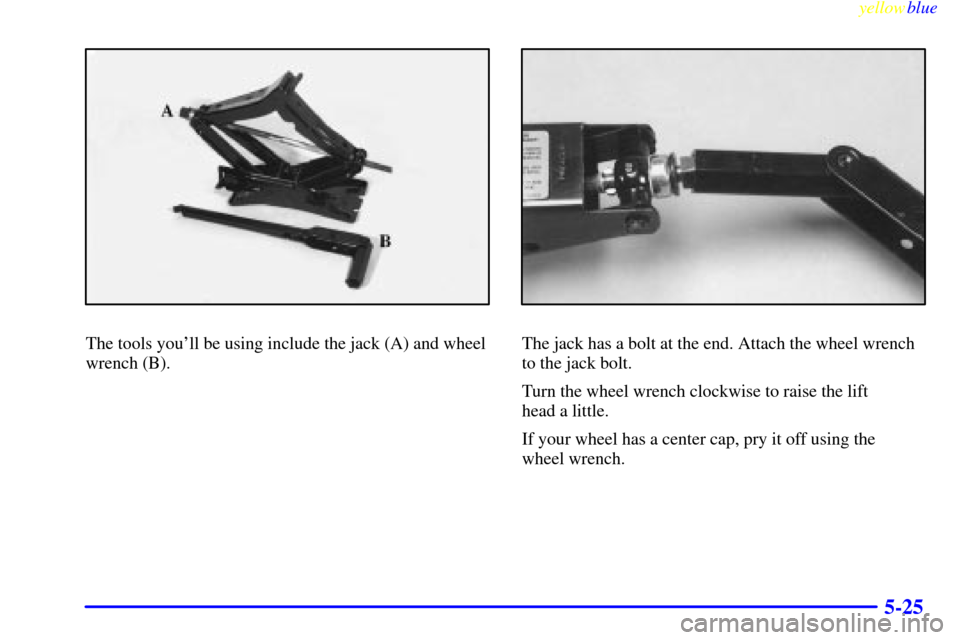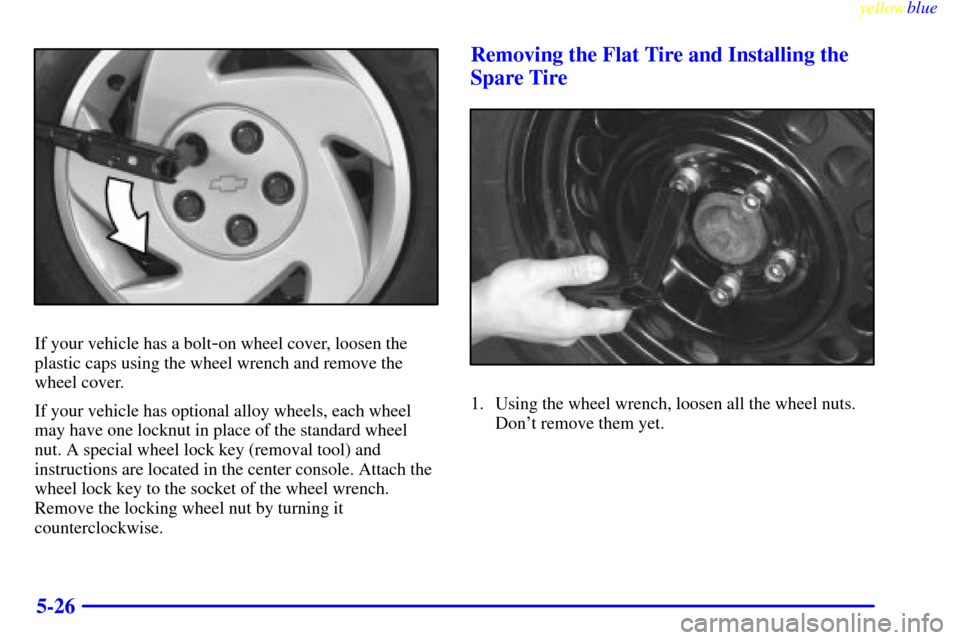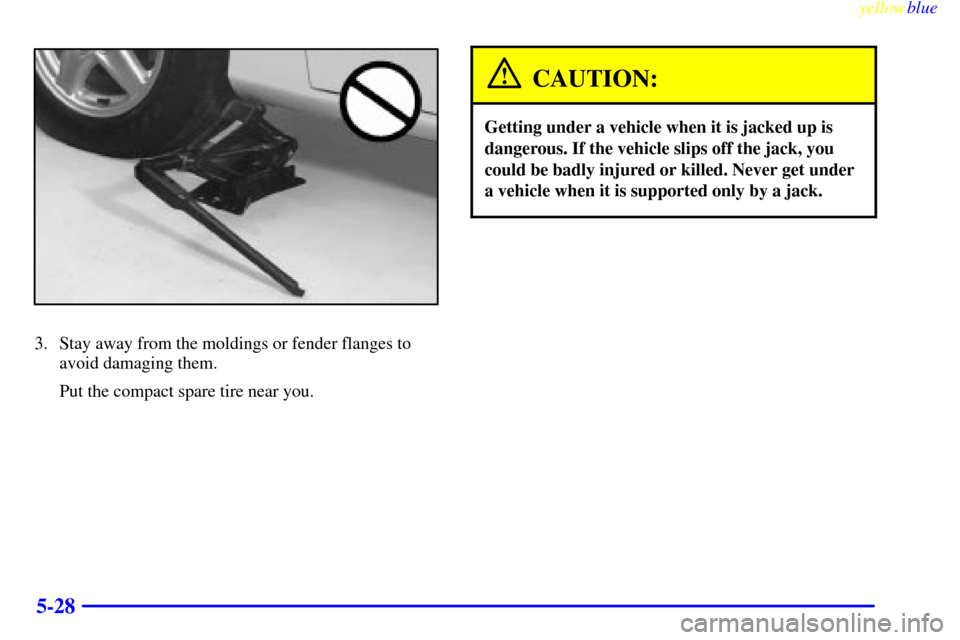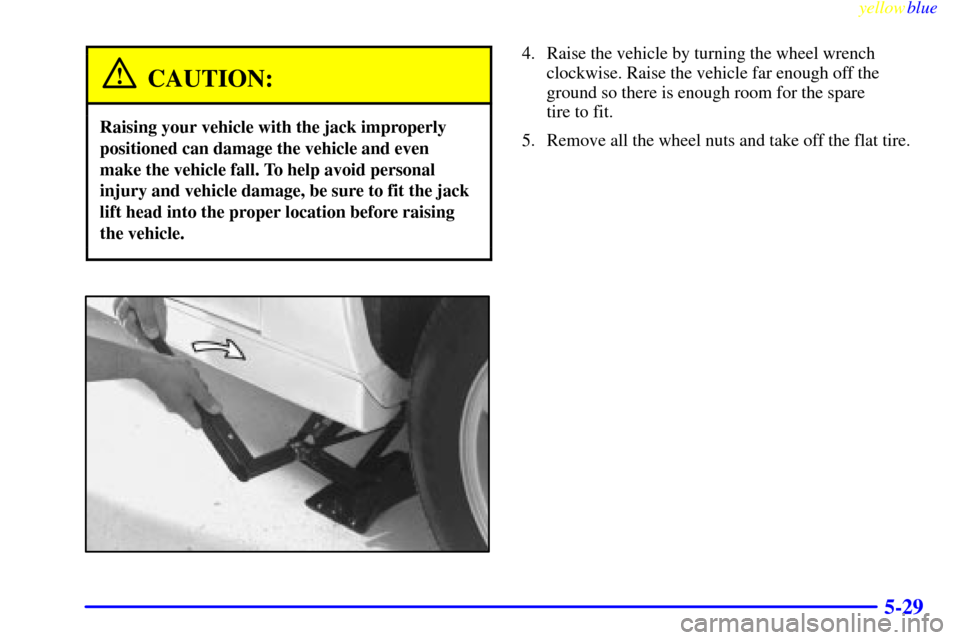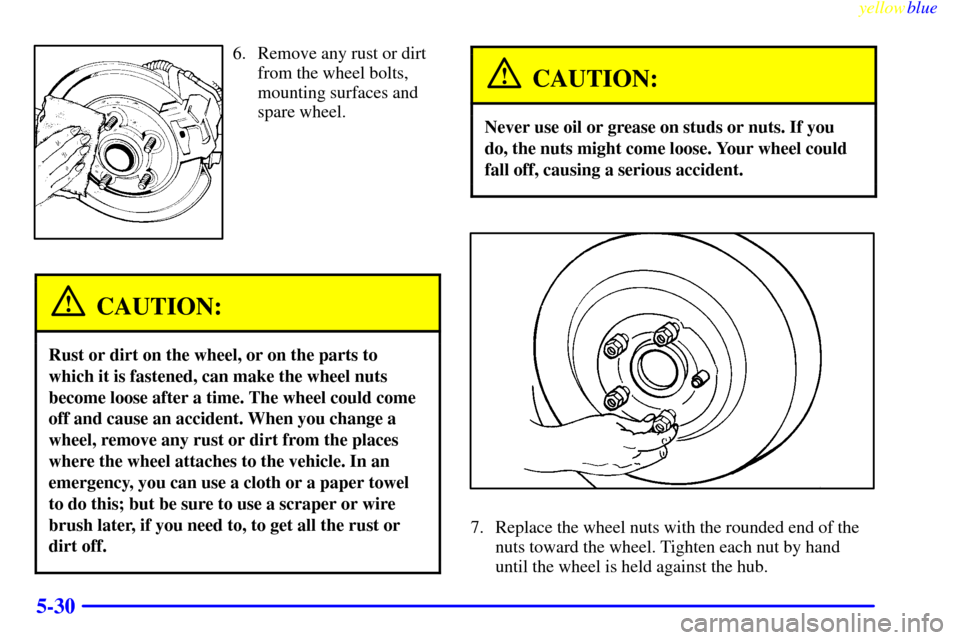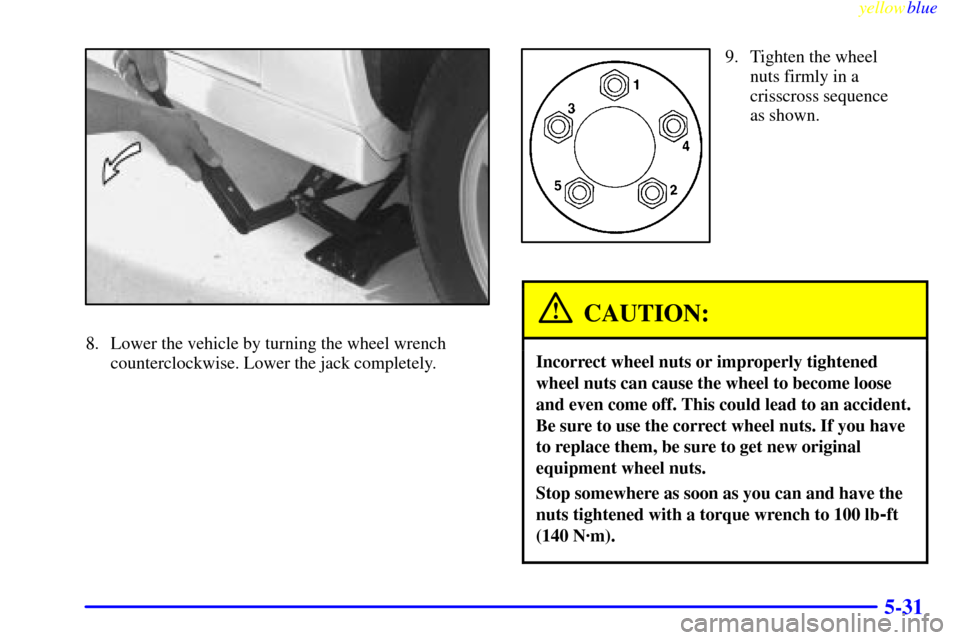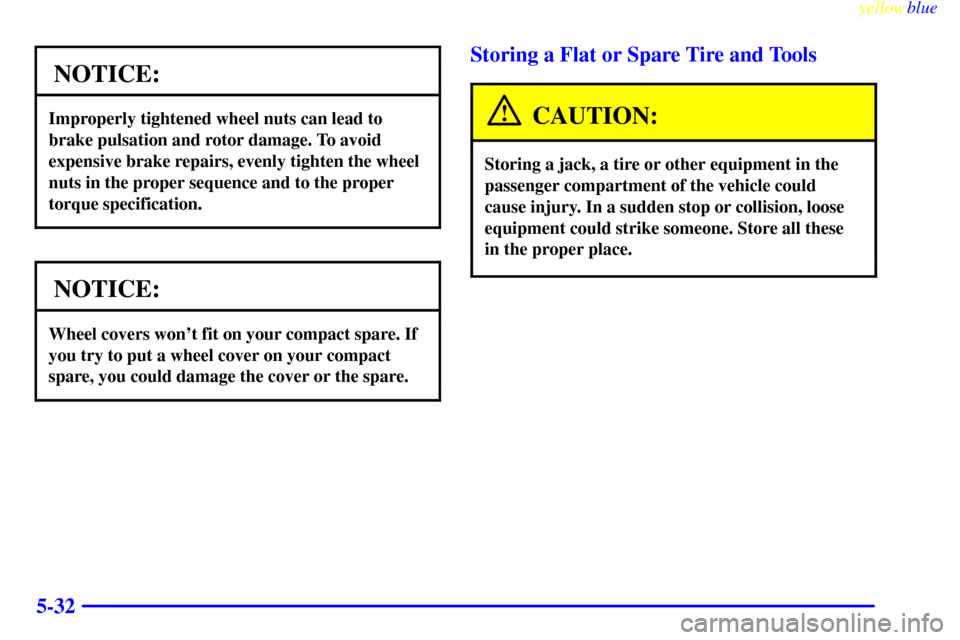CHEVROLET CAMARO 1999 4.G Owners Manual
CAMARO 1999 4.G
CHEVROLET
CHEVROLET
https://www.carmanualsonline.info/img/24/8056/w960_8056-0.png
CHEVROLET CAMARO 1999 4.G Owners Manual
Trending: fog light, brake, oil change, stop start, belt, brake pads replacement, oil capacity
Page 241 of 376
yellowblue
5-25
The tools you'll be using include the jack (A) and wheel
wrench (B).The jack has a bolt at the end. Attach the wheel wrench
to the jack bolt.
Turn the wheel wrench clockwise to raise the lift
head a little.
If your wheel has a center cap, pry it off using the
wheel wrench.
Page 242 of 376
yellowblue
5-26
If your vehicle has a bolt-on wheel cover, loosen the
plastic caps using the wheel wrench and remove the
wheel cover.
If your vehicle has optional alloy wheels, each wheel
may have one locknut in place of the standard wheel
nut. A special wheel lock key (removal tool) and
instructions are located in the center console. Attach the
wheel lock key to the socket of the wheel wrench.
Remove the locking wheel nut by turning it
counterclockwise.
Removing the Flat Tire and Installing the
Spare Tire
1. Using the wheel wrench, loosen all the wheel nuts.
Don't remove them yet.
Page 243 of 376
yellowblue
5-27
2. Position the jack under the vehicle. There is a notch
in the vehicle's rocker flange on the coupe model.
Raise the jack head until it fits firmly into the notch
nearest the flat tire.
On convertible models, place the jack in a
similar location.
Page 244 of 376
yellowblue
5-28
3. Stay away from the moldings or fender flanges to
avoid damaging them.
Put the compact spare tire near you.
CAUTION:
Getting under a vehicle when it is jacked up is
dangerous. If the vehicle slips off the jack, you
could be badly injured or killed. Never get under
a vehicle when it is supported only by a jack.
Page 245 of 376
yellowblue
5-29
CAUTION:
Raising your vehicle with the jack improperly
positioned can damage the vehicle and even
make the vehicle fall. To help avoid personal
injury and vehicle damage, be sure to fit the jack
lift head into the proper location before raising
the vehicle.
4. Raise the vehicle by turning the wheel wrench
clockwise. Raise the vehicle far enough off the
ground so there is enough room for the spare
tire to fit.
5. Remove all the wheel nuts and take off the flat tire.
Page 246 of 376
yellowblue
5-30
6. Remove any rust or dirt
from the wheel bolts,
mounting surfaces and
spare wheel.
CAUTION:
Rust or dirt on the wheel, or on the parts to
which it is fastened, can make the wheel nuts
become loose after a time. The wheel could come
off and cause an accident. When you change a
wheel, remove any rust or dirt from the places
where the wheel attaches to the vehicle. In an
emergency, you can use a cloth or a paper towel
to do this; but be sure to use a scraper or wire
brush later, if you need to, to get all the rust or
dirt off.
CAUTION:
Never use oil or grease on studs or nuts. If you
do, the nuts might come loose. Your wheel could
fall off, causing a serious accident.
7. Replace the wheel nuts with the rounded end of the
nuts toward the wheel. Tighten each nut by hand
until the wheel is held against the hub.
Page 247 of 376
yellowblue
5-31
8. Lower the vehicle by turning the wheel wrench
counterclockwise. Lower the jack completely.
9. Tighten the wheel
nuts firmly in a
crisscross sequence
as shown.
CAUTION:
Incorrect wheel nuts or improperly tightened
wheel nuts can cause the wheel to become loose
and even come off. This could lead to an accident.
Be sure to use the correct wheel nuts. If you have
to replace them, be sure to get new original
equipment wheel nuts.
Stop somewhere as soon as you can and have the
nuts tightened with a torque wrench to 100 lb
-ft
(140 N´m).
Page 248 of 376
yellowblue
5-32
NOTICE:
Improperly tightened wheel nuts can lead to
brake pulsation and rotor damage. To avoid
expensive brake repairs, evenly tighten the wheel
nuts in the proper sequence and to the proper
torque specification.
NOTICE:
Wheel covers won't fit on your compact spare. If
you try to put a wheel cover on your compact
spare, you could damage the cover or the spare.
Storing a Flat or Spare Tire and Tools
CAUTION:
Storing a jack, a tire or other equipment in the
passenger compartment of the vehicle could
cause injury. In a sudden stop or collision, loose
equipment could strike someone. Store all these
in the proper place.
Page 249 of 376
yellowblue
5-33
Replace the jack, wheel wrench and flat tire using the
storage instructions. When you replace the trim panel,
be sure to tuck it under the weatherstrip.
1. Trim Panel
2. Bolt
3. Cover
4. Jack
5. Wing Nut
6. Adapter
7. Compact Spare Tire
8. Full
-Size Tire
9. Carpet Flap
10. Tire Storage Bolt
11. Trunk Access Panel (Convertible Only)
12. Knob
Page 250 of 376
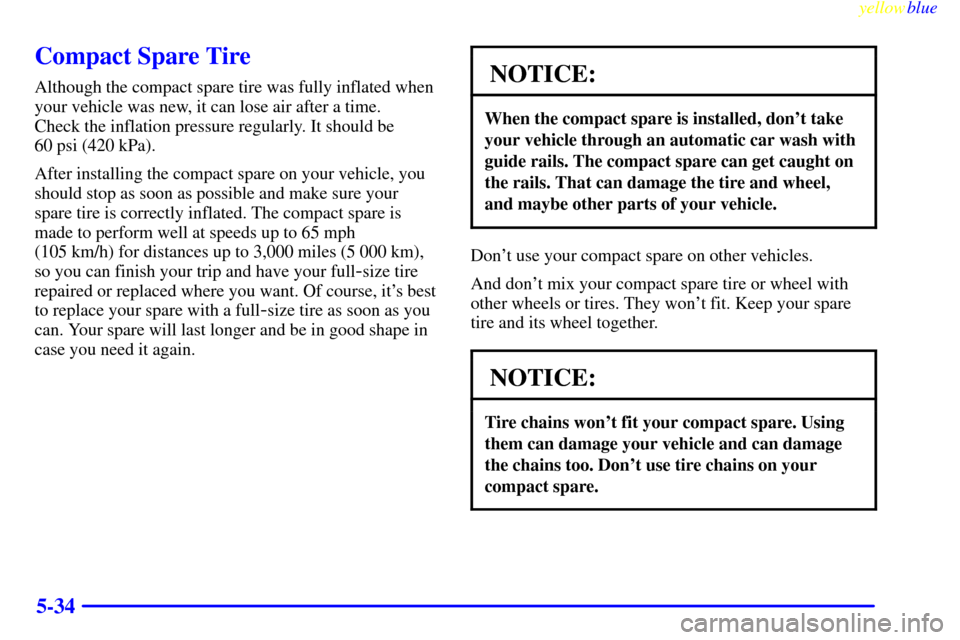
yellowblue
5-34
Compact Spare Tire
Although the compact spare tire was fully inflated when
your vehicle was new, it can lose air after a time.
Check the inflation pressure regularly. It should be
60 psi (420 kPa).
After installing the compact spare on your vehicle, you
should stop as soon as possible and make sure your
spare tire is correctly inflated. The compact spare is
made to perform well at speeds up to 65 mph
(105 km/h) for distances up to 3,000 miles (5 000 km),
so you can finish your trip and have your full
-size tire
repaired or replaced where you want. Of course, it's best
to replace your spare with a full
-size tire as soon as you
can. Your spare will last longer and be in good shape in
case you need it again.
NOTICE:
When the compact spare is installed, don't take
your vehicle through an automatic car wash with
guide rails. The compact spare can get caught on
the rails. That can damage the tire and wheel,
and maybe other parts of your vehicle.
Don't use your compact spare on other vehicles.
And don't mix your compact spare tire or wheel with
other wheels or tires. They won't fit. Keep your spare
tire and its wheel together.
NOTICE:
Tire chains won't fit your compact spare. Using
them can damage your vehicle and can damage
the chains too. Don't use tire chains on your
compact spare.
Trending: height adjustment, set clock, child seat, tire pressure, fuel fill door release, jump start terminals, tires
